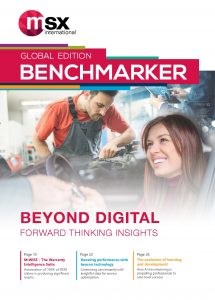Changing the rules of warranty:
How MSX is driving digital transformation
by Nikhil Arora, Lead Product Manager
Economic uncertainty, emissions regulations and steadily growing competition are all adding to the increasing pressure on OEMs to work more efficiently and cut costs. And with billions of dollars spent on managing claims annually, warranty is an obvious place to start.
Traditional models for managing warranty rely on legacy IT systems and manual, outdated processes which are no longer affordable or manageable, nor do they support changes in industry demands. Connected vehicles and telematics, such as on-board diagnostics, are increasing vehicle complexity. In turn, first-time-fix rates are lower, and warranty claims processes are open to greater inaccuracies while technicians struggle to upskill.
But new warranty models are emerging that help OEMs operate more sustainably. Manufacturers are investing in multi-tenant solutions whereby a single software instance and its supporting infrastructure serves multiple customers. This cuts costs for manufacturers, who can benefit from leading warranty solutions while sharing the investment in software development and knowledge. It also frees up time and money to invest in improvements to vehicles before potential faults become warranty claims.
MSX is working with major manufacturers to deliver future-proof, digital warranty services. Its M:WISE platform uses artificial intelligence (AI) to score all claims. It then automates processing of the straightforward ones and allocates those most likely to contain problems to claims handlers be processed manually. This model uses machine learning to quantify the probability of savings within claims, but MSX’s solutions roadmap includes multi-tenant applications that expand the AI model to see beyond probability and seek additional factors such as anomalies or incorporate new variables.

Among these tools is an advanced, dynamic rules engine – a modular and transparent solution that will allow OEMs to modify the rules of claims selected for assesment, quickly and easily. Ultimately, even the audits themselves will be automated. Technologies like these help OEMs slim down the number of claims that require human intervention and give them more control and confidence to automate more processes without fear of compromise to their unique specifications or accuracy.
Multiple technologies play a part in decreasing the need for human intervention. MSX is employing optical character recognition (OCR), for example, to understand handwritten claims so they can be automatically processed. And natural language processing (NLP) analyses language or speech, so technologies can understand spoken queries and generate automated responses that closely resemble human interaction.
MSX is also working with image recognition. A dealer submitting a claim, for example, will select an image of a car part, so the warranty platform can instantly recognize the fault. Meanwhile, manufacturers will offer dealers automated, guided repair and briefing systems and other support services to significantly reduce their response times and provide a higher level of service.
OEMs can expect to avoid the costs of expensive work mistakenly carried out under warranty. MSX is working on a pre-approval platform, whereby manufacturers can authorize high-value claim decisions before dealers start work on repairs, preventing invalid claims and providing reassurance and potential cost savings to the dealer.
M:WISE benefits for your organization
Improvement in
Rejection Rate
Increase in manual
review process accuracy
Upliftment in
savings
Manufacturers currently spend in the region of $50 billion to manage the warranty bill – an expense that is expected to reach $61 billion by 2023. MSX is helping manufacturers recoup some of these costs. Its warranty claims prediction engine can generate 70% more value for the same volume of claims assessed. One manufacturer has seen significant improvements in selection hit rates in just six months. Previously, 10% of claims that were selected for audit generated savings, whereas now the success rate is closer to 45%.
The tools also help manufacturers accurately predict and plan for their warranty bill. Using traditional models, OEMs find it difficult to predict warranty costs. The industry currently over-accrues warranty by up to 45%. If they can predict expenses more accurately using warranty cost prediction tools, manufacturers will free up significant funds to invest elsewhere.
MSX’s warranty control roadmap is steering warranty’s future towards greater financial control, smarter decision making, risk mitigation and stronger relationships between OEMs and dealer networks. Its solutions not only resolve today’s problems, but also deliver early warning systems to help manufacturers take a more proactive approach to controlling their future.
 About the Author:
About the Author:
Nikhil Arora
Lead Product Manager
Nikhil is a global professional with extensive leadership experience across product management, business management and technology consulting. He has worked with automotive clients, as well as businesses across the manufacturing and insurance industries. He graduated from INSEAD in 2018, specialising in decision science, strategy and entrepreneurship, and is now leading product development at MSX’s Digital Innovation Hub in Berlin.
He can be reached at NArora@msxi-euro.com
: For more insights about MSX, download our latest
Benchmarker 2019





